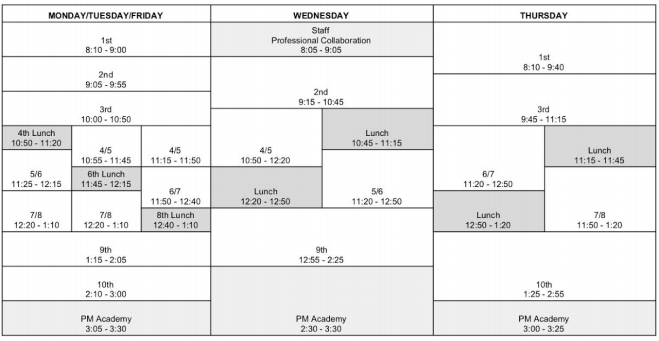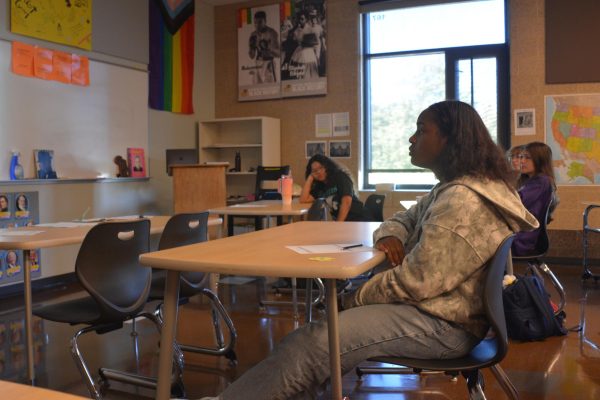Administration Announces New Bell Schedule
BHS will have a new bell schedule for the 2019-2020 school year.
Notable changes include a later start time of 8:10 a.m. on Monday, Tuesday, Thursday and Friday. Wednesday classes will begin at 9:15 a.m.
Academy will be every day after school, pushing the end of the school day to 3:30 p.m.
“I do think it’s important that we collect as much feedback from as many stakeholders as possible,” Principal Tony Srithai said. “With that said, I also wanted to ensure that in terms of our guiding principles, we’re always doing what’s best for students.”
The 2018-2019 schedule included a start time of 7:35 a.m., 15 minutes earlier than previous years, while academy was incorporated in the middle of the school day.
A Beachcomber survey conducted last year revealed a largely negative response to this schedule, with 74.1% of respondents indicating that they felt it was worse than the previous one.
Data also revealed a significant increase in tardies, which may have been linked to the earlier start time and a stricter implementation of tardy policy.
A BHS scheduling survey analysis conducted by the school administration showed that respondents were “most concerned about the new schedule’s daily start time and weekly inconsistencies associated with the block schedule.”
For example, some students expressed confusion regarding changes to the schedule on Thursdays due to assemblies and standardized testing.
“It changes way too commonly,” one respondent wrote. “I have been tardy because I didn’t know that the schedule changed for a Thursday.”
“A lot of times we would get the schedule in the beginning of the week, [but] some people who didn’t check their emails [wouldn’t know about the change until] the day of in the morning when it was sent through Remind,” sophomore Sunny Wang said. “It’s definitely up to the students to adapt and come to school on time; that’s their responsibility, but it would be nice if it was easier to do that.”
Math teacher Lisa Morgan feels that consistency in the daily schedule is most important.
“It’s the fact that we change our [start] times so much that causes problems with establishing a routine for students… We need routine,” Morgan said. “Thursdays threw us into a bigger loop… That impacted more of our kids.”
“I thought [the schedule] was inconsistent because I just don’t think [the administration] planned really far ahead when they were making this year’s schedule—that’s why they kept needing to adjust it for different assembles,” Wang added. “I hope that with this new schedule and the consistent PM academy, maybe they’ll be able to limit the [number of changes].”
Srithai said the new schedule will address the inconsistencies of this year’s schedule.
“Students expressed a desire for a more consistent start time, so now there’s no flexibility around what time we start on Thursdays,” Srithai said. “Now, we’re just going to have Thursday start at the same time every week, and we’ve built [PM academy] at the end of the day.”
According to Srithai, a later start time has always been on the table.
“This year, with our most recent changes, we weren’t able to pull that off,” he said. “Moving the high school start time impacts every other school in the district, from the middle school to Fairmount and Bryden, [so] this has been a drastic shift district wide. We needed to afford ourselves the time to make sure that we have a plan in place for all these other buildings before rolling [the new schedule] out.”
Next school year, the middle school will begin at 8:15 a.m. instead of 7:30 a.m. Bryden and Hilltop will both begin at 7:40 a.m.
Most BHS students feel that the later start time will be beneficial.
“I think it’s great for students—I think it’s great that they pushed back the start time so students can get more sleep in the morning,” junior Gabe Colmenares said.
The American Academy of Pediatrics supports later start times in middle and high schools, recommending a start time of 8:30 a.m. or later.
“A substantial body of research has now demonstrated that delaying school start times is an effective countermeasure to chronic sleep loss and has a wide range of potential benefits to students with regard to physical and mental health, safety, and academic achievement,” the Academy stated.
However, according to a study completed in 2014, 93% of high schools and 83% of middle schools in the U.S. started before 8:30 a.m.
“Being able to sleep more obviously just benefits the entire mentality and learning environment,” Wang said. “There are times when you get home really late and you don’t have time to do homework, so having that choice of being able to wake up early… to work instead of just [going] to school with homework that’s not done [is really nice].”
While students might benefit from a later start time, Colmenares believes that the longer school day will place a burden on teachers.
“It’s forcing them to stay later in the day, which messes with a lot of the teachers’ schedules that have already been in place so far,” he said.
On the other hand, Wang feels the new schedule will also benefit teachers.
“With this present schedule, a [big issue] is that the kids who don’t have academy during the time that the teachers have academy or no academy at all just come in whenever they need help, but sometimes teachers are in the middle of planning period or their personal time and they can’t help the student,” Wang said. “But it’s not fair for that student and the staff to have to work around that.”
Morgan says there will always be pros and cons.
“For some faculty members, [the later start and end time] will be easier for their home routines, and for some faculty members it will be more challenging,” she said.
Srithai believes that the new start time will be positive for some teachers.
“We have some staff members who historically have had trouble either getting their kids to daycare, nursery, Pre-K or seeing them get on the bus in the mornings while making it [to school] for a 7:35 start time. Shifting [the start time] hopefully accommodates their personal lives in a more direct way,” Srithai said.
This year, student opinion was divided on mid-day academy.
Colmenares found it more convenient.
“[Prior to this year,] because my parents drive me to school, I felt like I had to… make sure that my parents knew that I was going to academy early in the morning,” he said. “With this schedule, it felt like I already had that time worked into my day, so I felt like it was easier for me to walk into an academy.”
However, freshman Ingrid Maier thought that academy times this year were inconvenient.
“If you have a test… in the beginning of the day before the academy, you can’t go ask your teacher about it,” she said.
Wang agreed.
“With this present schedule, some students such as myself don’t have 6th period academy… and some students don’t have academy at all during the middle of the day, so the only time we can see certain teachers is Wednesday afternoon,” Wang said.
When designing the new schedule, Srithai wanted to implement a more consistent academy period in the school day.
“We wanted to make academy the most accessible to the most number of students,” he said. “Now, a consistent academy schedule hopefully makes it the most available time to the most number of students.”
However, teachers such as Morgan are concerned about the lack of flexibility. Now, teachers no longer have the option of choosing between an AM or PM academy.
“We have had flexibility in academy time in the past, and it has offered more options for our students, whereas having the exact same academy time for all teachers in this school cuts the number of academy times in half,” Morgan said. “Even with this year’s schedule, [students] had 6th academy and 7th academy, so [they] still had that ability to see more than one teacher in a day.”
With all teachers only available during one 25-minute academy period each day, Morgan said, students might not be able to seek help from more than one teacher per day.
“If there’s a lot of people in the room, you might not get your questions answered and still have time to go see [another teacher],” she explained.
“Having one big academy in the afternoon… there’s going to be so many people there and it’s going to be chaotic,” Wang added.
Overall, students remain open-minded about the new schedule.
“Every schedule has its problems,” Wang said, “but as of right now, I think the academies will be better this way for both students and staff members.”
“I’m excited to see how it works out,” Colmenares added.

Vivian Li began writing for the Beachcomber in 2016. She covers various news and feature stories in BHS and the community. In addition to writing for the...





![“My parents have always said that education is important. My parents are Chinese immigrants, I'm Chinese American, [and that's a] value that has always been ingrained in our community,” said Senior Lyndia Zheng, pictured with Tony Zheng](https://bcomber.org/wp-content/uploads/2025/10/DSC_4244-600x400.jpg)






